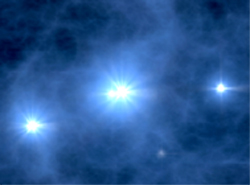

The discovery that the universe is made up largely of mysterious dark energy and dark matter tops the biggest ten breakthroughs of the year chosen by
Science magazine.
The magazine annual "Breakthroughs of the Year" section focuses on advances that have profoundly changed the practice or interpretation of science or its implications for society.
1. Illuminating the Dark Universe. NASA's Wilkinson Microwave Anisotropy Probe (WMAP) satellite began its voyage into deep space to explore some of the deepest mysteries of the cosmos on June 30, 2001. Scientists hope to determine the content, shape, history, and the ultimate fate of the universe by constructing a full-sky picture of the oldest light. In February, WMAP produced an image of the infant cosmos, of all of creation when it was less than 400,000 years old. The brightly colored picture marks a turning point in the field of cosmology: Along with a handful of other observations revealed this year, it ends a decades-long argument about the nature of the universe and confirms that our cosmos is much, much stranger than we ever imagined.
2. Decoding mental illness. Schizophrenia, depression, and bipolar disorder often run in families, but only recently have researchers identified particular genes that reliably increase one's risk of disease. Now they're unraveling how these genes can distort the brain's information processing and nudge someone into mental illness.
3. Climate change impacts. Among the findings this year, climate modelers linked a now fading, years-long, globe-girdling drought to unusually warm waters in the western Pacific and Indian oceans. That warm water looks to be a product of greenhouse gases. In the Arctic, river monitoring showed a 7% increase since 1936 in the flows of the six largest Eurasian rivers that empty into the Arctic Ocean. That fits climate model predictions of increased high-latitude precipitation and follows the observed warming and atmospheric circulation trends. More freshwater flooding into the far North Atlantic could slow the northward flow of heat-laden currents and thus disrupt climate around more populous parts of the North Atlantic region.
4. RNA's many roles. MicroRNAs, the runts of the RNA litter at about 22 nucleotides in length, were found to guide early development--from shaping plant leaves to mediating cell proliferation in fruit fly embryos. RNA interference (RNAi), which shuts down gene expression, also plays a critical role in development. Mice lacking an RNAi protein called Dicer lost swaths of stem cells and died before birth. Also this year, certain microRNAs in mice were found to help direct stem cells that create the embryo's blood cell system. Humans, meanwhile, are now thought to harbor as many as 255 genes that encode microRNAs--nearly 1% of the genes in the entire genome.
5. Single-molecule techniques. New collaborations between biologists and physicists are detailing the busy lives of single molecules, in real time, as they buzz about their business in the cell. Work this year captured molecular motors in motion; refined long-lasting, nanoscale, Technicolor markers; and revealed some basic properties of a single enzyme bound to DNA.
6. Gamma ray bursts. Several discoveries this year lifted veils that had shrouded the most energetic explosions in the universe: titanic blasts of energy called gamma ray bursts (GRBs). Most notably, in March, astronomers confirmed the connection between GRBs and supernovas--the death throes of massive stars--when they spotted the unmistakable imprints of a supernova in the glow of a bright GRB. Astrophysicists now believe that the burst's jets of energy spewed into space when a star's core imploded, forming a black hole or--in a minority view--a rapidly spinning neutron star with a crushing magnetic field.
7. Sex cells from stem cells. At least one observer called the surprise discovery an "ethical earthquake": Mouse embryonic stem (ES) cells can develop into both sperm and egg cells in culture dishes. The work hatched both scientific and ethical questions. In the short term, the discoveries should help reveal how germ cells develop. If the feat can be reproduced in human cells, it could provide a renewable source of human eggs or sperm for research. But it also opens a Pandora's box of ethical questions: Could a child be born whose genetic parent is a cell line?
8. "Left-handed" materials. After 2 years of debate, work this year confirmed that certain oddball materials are capable of bending light in the wrong direction. Materials bend light and other types of electromagnetic radiation according to a property known as their index of refraction. The bigger a material's index, the slower light travels through it, and the more light bends. A change in refractive index is why a straw in a glass appears to have a kink where it enters the water. In natural materials, light always bends at a positive angle with respect to the angle at which it entered.
9. Y chromosome sequence. A sequencing tour de force revealed the genetic code of the Y chromosome this year and in the process earned new respectability for the stubby piece of DNA that makes a man a man. Half of the 59 million bases in this chromosome are jumbled, possibly useless, and virtually impossible to decipher. This "junk" suggested that the Y is slowly fading as a chromosome. But the new sequence of the other half of Y's DNA, which contains the genes, shows that it has evolved an unusual, but effective, way to take care of itself.
10. Anti-angiogenesis treatments. It's been a roller-coaster ride for researchers working on anticancer drugs that block development of the blood vessels that feed tumor growth. They've seen their field bounce from obscurity and skepticism to superhype--after a 1998 article in The New York Times suggested that antiangiogenesis drugs, as they are called, would cure cancer in 2 years--and then back to skepticism when early clinical trials produced unimpressive results. But this year, they've finally begun to see their efforts pay off.








